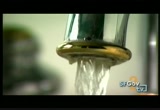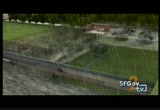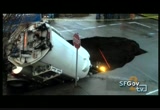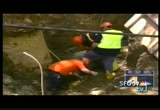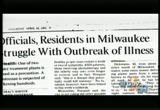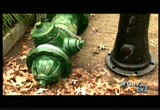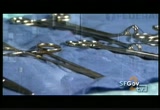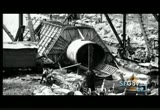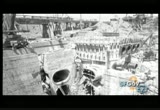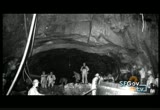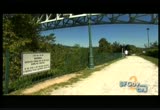tv [untitled] November 12, 2012 6:00am-6:30am PST
6:00 am
it takes huge investments to ensure that wastewater and drinking water treatment plants function properly to maintain a safe water supply. we made the initial investments in the plants and the pipes. but once we accomplished that, there was this great recognition that we had a series of issues associated with wet weather conditions. storm events where, all of a sudden, you're dealing with a lot of water. narrator: large amounts of rainwater can cause flooding. engineers developed two approaches to stormwater infrastructure to transport water away from the urban environment. one approach was to carry waste and stormwater through the same pipe. this combined system was less expensive than building two individual pipe networks. and stormwater was seen as a way to flush out the sewers. through the 19th century, the combined system was considered state-of-the-art
6:01 am
throughout the world, and is still in use in many cities today. but cities constructed these systems before treatment was the standard. and even today's largest treatment plant doesn't have the capacity to treat the sudden volumes of water rushing through a combined system during rain. the plant is overloaded, and the excess rainwater, mixed with untreated raw sewage, is diverted straight into local waterways, creating a combined sewer overflow, or cso. there are over 700 communities in the united states with combined sewer systems. the other approach was to separate wastewater from stormwater, using two pipe networks. this separate system simply carries the stormwater away from the city. but even separate systems pollute the watershed. in developed areas, concrete and other impervious services prevent water from naturally soaking into the land. as the rainwater moves over the roads
6:02 am
and concrete expanse, it captures trash and invisible chemicals, sending them straight to the nearest waterway -- untreated. when engineers first designed america's water infrastructure -- the drinking water, wastewater, and stormwater systems -- they were some of the most advanced in the world. but the infrastructure is growing old. and population growth and development, particularly in urban areas, have made it difficult for original system designs to meet modern health standards and reliably satisfy demand. man: our water and wastewater systems really are engineering marvels. because it's buried, it's invisible to us, and we tend to take it for granted. that's a mistake. like any engineered system, it requires maintenance and periodic rehabilitation,
6:03 am
and eventual replacement. it's so out of sight and so out of mind, that we don't realize the danger we're in. people see that their roads can cave in. their bridges are falling apart. the concern is that also the infrastructure that they can't see is falling apart. you wouldn't let your house be 100 years old and not ever do any maintenance to it. you would make sure that it was safe. 100 years ago, teddy roosevelt was president, and your pipes were brand new. now, our infrastructure is old.
6:04 am
100, 200 years old. it's not been upgraded or fixed or replaced, sometimes, ever. man: if these systems are not maintained, sooner or later they're going to fail. they all have a life expectancy. if you don't maintain them and constantly check them and then do what's necessary to rehabilitate or repair, you're going to have a big problem. and they're going to collapse. they're going to fail. and all of a sudden, the water, or the sewage that normally goes through them, will not have any place to go. it'll back up into homes, it'll back up onto the street. it's normally out of sight, out of mind. once it comes to the surface, it's a whole 'nother animal. melosi: you're talking about system-wide problems that would take tremendous human resources to correct. this is true with drinking water, as well as wastewater. man: first, our top story. thousands of people are without water tonight.
6:05 am
woman: a flash flood of the manmade kind. apparently, a 12-inch pipe burst. take a look behind me. this water main break shut off water to 2,200 residents. woman: how many breaks are you working on right now? we have 24 breaks working right now. man: in our company, washington suburban sanitary commission, we had 479 water main breaks in february -- the most ever, for any february. man: this 10-inch water main in willard park is 73 years old. man: at wssc, we're having a year of record -- a ramp up slope of water main breaks that soon is going to reach exponential. man: the damage has been done. and this is the culprit. brunhart: today, 25% of our 5,500 miles of underground water pipes has reached the end of useful life. by the year 2020, 85% will have reached the end of useful life. woman: what to do? wssc is working on that costly problem right now. brunhart: it's not only true here, but it's true throughout our nation. narrator: across the united states, cities and towns are facing the challenge
6:06 am
of aging and outdated drinking water, wastewater, and stormwater infrastructure. it's a national problem. but it needs to be approached system by system. allbee: let's frame the systems in terms of the proper context. we have around 16,000 wastewater systems. we don't have a single wastewater system -- we have 16,000 of them. we have about 54,000 drinking water systems. narrator: issues facing new york city are very different from those in los angeles. and challenges facing small towns are very different from those in metropolitan areas. man: we have to have water supply for health purposes, for fire protection, and the economy. without it, things simply can't exist. woman: we have good health in this country, in part, because we have clean water. and we shouldn't forget that, and we shouldn't take it for granted.
6:07 am
melosi: in the late 19th century, serious waterborne disease epidemics were having devastating effects. roy: but then, in the early 1900s, we began to treat our water. and since then, we've seen a rapid decline in the incidence of waterborne disease. narrator: most cities treat drinking water through filtration, chlorination, and sometimes ozonation to kill pathogens in the source supply. these are complex treatment plants that cost millions of dollars to operate, but are necessary for our wellbeing. the treatment of drinking water has been called one of the greatest public health achievements of the last century. the water infrastructure itself protects the treated water until it comes out of our taps. it's been since 1911, since we had an outbreak of cholera or typhoid in the united states. but that doesn't mean that it can't happen. it can happen.
6:08 am
if we aren't on our guard all the time, we are vulnerable to going right back where we were in 1911. in milwaukee, health experts are taking a close look at the public water supply. in milwaukee, thousands of people have been getting sick. man: private distributors of bottled water are sending extra supplies as fast as possible. health officials blame a microscopic parasite called cryptosporidium. man: in the 1993 cryptosporidium outbreak, over 400,000 people became ill with diarrhea, cramping and nausea, and we also recorded over 100 deaths, primarily in the immuno-compromised community, and in particular, individuals with aids, or hiv infection. man: people were beginning to experience symptoms of diarrhea. it started to become more and more widespread. so the natural spot to look was drinking water. so tests were run on the water coming out of both of our water treatment plants. and we found cryptosporidium coming out of our howard avenue plant. man: milwaukee officials are shutting down
6:09 am
one of the city's two water purification plants. biedrzycki: cryptosporidium is a parasite that's found in the gut or intestine of both humans and animals, and found in many surface waters throughout the globe. prior to 1993, it was not on our radar. it was not a reportable disease. narrator: epa standards did not safeguard against cryptosporidium, because it was an unknown threat. once it contaminated the water supply, the treatment plant had no capability to kill the pathogen. so it spread throughout the system. biedrzycki: we saw an expenditure of $90 million to upgrade both water treatment plants. kaminski: cryptosporidium was a wake-up call. it was a wake-up call for us. it's a wake-up call for the nation. take care of your infrastructure before you have the kind of problem we had. biedrzycki: by no stretch of the imagination do i think we're out of the woods. recent cdc statistics indicate that up to 32 million cases of waterborne disease occur each year in this country.
6:10 am
roy: but the vast majority of waterborne outbreaks go undetected. when people first get ill, they think, "oh, it's something i ate last night." they don't think, "oh, it's something i drank last night." narrator: the milwaukee incident pointed out the potential vulnerability of our drinking water infrastructure in controlling the spread of illness. biedrzycki: it's incumbent upon us to try to stay ahead of the curve, but it's very, very difficult. there's always another bug on the horizon. narrator: in 2008, the associated press reported that water quality testing across the nation uncovered trace amounts of pharmaceutical compounds in the drinking water supplies of millions of americans. the health effects of these low levels of medications diluted in our water are still being determined. but these findings further illustrate the fundamental relationship of infrastructure to health. the quality of water plays a significant role
6:11 am
in public health. but reliable quantities of water play a significant role in public safety. [ sirens ] the water that comes out of the fire hydrants is the same water that you are utilizing to drink out of your own faucets in your home. so it is critical that we have the best and optimal water distribution system that we can tap into. johnson: in the mid-1990s, the water system had just about collapsed. the district had just run into some very dire financial circumstances, and, when those kinds of things happen, the very first thing that goes is maintenance of those things that one does not see. egan: you have hydrants that were manufactured in the 1800s. you have underground pipes, you have underground valves. they get what they call tuberculin built up. you would compare it to a 100-year-old man
6:12 am
that has heavy cholesterol. they could be 6- or 8-inch mains, but being 100 years old, they actually may be 2-inch mains. and they reduce the amount of volume of water that's available to us. johnson: there were a number of things that we have had to do in order to get the system back up to an acceptable standard. replacing mains and valves and fire hydrants and other components of the system to ensure that it operates properly. egan: we consider both the underground infrastructure and the above ground assets to be a part of the critical infrastructure of the city. johnson: and if the infrastructure is not there to actually deliver that water in the volume and the quality that's necessary, then communities simply can't exist. man: infrastructure is vital to the american economy.
6:13 am
water, after all, is an essential ingredient in hundreds of thousands of everyday products. narrator: agriculture and industry use roughly 80% of the water consumed in the united states. water is the basis for manufacturing many goods and provides the ability to clean and sterilize everything from computer chips to the surgical instruments used in hospitals. kelly: the minute that there's not enough water for businesses, industry, and individuals, they have to go elsewhere. and when they go elsewhere, jobs go elsewhere. your entire economy begins to suffer with the lack of clean water. narrator: while the water infrastructure provides for our health, safety, and economy, a growing concern is that the value society derives from water has not traditionally been reflected in the price we pay for water.
6:14 am
man: when you take a look at how much people pay for water, as a percentage of median household income, it's usually less than 1%. and when you compare that to how much we pay for electricity and gas, cable tv, and internet, the bottom line is, in the united states, we don't pay a heck of a lot for water. curtis: at an average cost of about $2.50 for 1,000 gallons of tap water, it is a great bargain. garvin: but the rates that are being charged for water are insufficient to replace existing systems and to expand existing systems. narrator: because original infrastructure investments were frequently subsidized by the federal government, water pricing was often calculated without accounting for the initial cost to build the systems. we made major investments in assets in the '50s, '60s, and '70s. and for the first 40 years of that pipe,
6:15 am
there really may not have been many maintenance requirements. we're past that period now. narrator: water pricing based only on day-to-day operation, and not on planning for maintenance and eventual upgrades has resulted in a considerable repair and replacement backlog. allbee: on a national scale, if you looked at what we're spending now, and you looked at the additional investment requirements over the next 20 years, there's a $540 billion difference. man: so one of the greatest challenges is to reflect true value pricing. so that the citizens and businesses that rely on water and wastewater infrastructure systems are actually paying for it. narrator: cities and municipalities across the united states are now facing this funding gap, between projected revenue and projected expenses, as they strive to maintain water quality and meet demand.
6:16 am
new york is the most densely populated city in the u.s. and over 40 million tourists visit the city every year. the 1.3 billion gallons of water required every day are delivered by a system of extraordinary scale and complex engineering. man: water is essential to the economic viability of new york city. reliable infrastructure and reliable delivery of water is a must. you have to reinvest in the infrastructure every single minute to keep it current. hurwitz: we have the stock exchange, we have the united nations -- failure can have a dramatic impact on the nation, and even internationally. so there's a really keen awareness that you always have to be fixing the system. things corrode, they rust.
6:17 am
they get to where you turn them on and nothing happens. but it is so totally used in every nook and cranny, that making any accommodation to shut it down, to do something to it, is very difficult. narrator: two massive underground tunnels, called simply tunnel 1 and tunnel 2, provide most of the city's water supply. they run hundreds of feet below manhattan, far deeper than the subways. built at the beginning of the 20th century, they are concrete-lined and bored through solid rock. they could last centuries. but the mechanical equipment within them will not. engineers in the 1950s discovered rust on the tunnel's valves. there were concerns that if they closed the valves for tunnel inspections, they may never open again, leaving new york city without water. so they chose to keep them open.
6:18 am
as a result, there has not been significant inspection, maintenance, or repair of the tunnels in decades. no one knows their current condition. hurwitz: currently, city tunnel 1 and city tunnel number 2 would be feeding each half of the city. so you'd lose half the city if you didn't have a replacement. narrator: without half of its water supply, the city would shut down. for nearly 40 years, new york has been in the process of constructing a solution. man: this project is water tunnel number 3. we started on this project in 1969. i'm a sandhog. i've been a sandhog for 37 years. narrator: sandhogs are the men of local 147, who work deep below the city. they began building the infrastructure of new york in 1872. from the subways to the sewers,
6:19 am
the water tunnels to the highway tunnels, new york city thrives because of their work. ryan: you got one little hole in the ground, and nobody knows we're here. see the empire state building, right. that's 1,000 feet. so you figure, you go down 1,000. how high that is -- that's how far we go down. narrator: stretching more than 60 miles under the city, tunnel 3 is taking generations of workers to complete. ryan: i don't even want to imagine what my father had to go through. when we first started, it was a rough job. everything was dynamite.
6:20 am
now, they have these machines called "moles." it's like a big drill, and it just cuts right through the ground. so there's no more dynamite. and it's still a rough job, but it's gotten to a point where it's a lot safer. in the '70s, we lost a man a mile basically. here, maybe we've had two or three deaths in the last 20 years, which is too much anyway, but it's cut down a lot. hurwitz: city tunnel number 3 will be an opportunity to take city tunnel 1 out of operation and rehabilitate it. city tunnel number 1 had one valve to shut off the whole tunnel. city tunnel 2 had two parallel valves. city tunnel 3 has 32, so there's much more redundancy. lloyd: we're targeting a completion date of 2012 for tunnel 3. and we already are starting to prepare to take tunnel 1 offline. narrator: the construction of tunnel 3 is vital for maintaining the sustainability
6:21 am
of new york's drinking water infrastructure. but the pipeline is useless if there's not a reliable supply of clean water within it. hurwitz: the city bought up land around the reservoirs to prevent it from development. it provides assistance to local residents to see that there's no pollution of the reservoirs. it's much more cost effective to prevent pollution and to protect a source of water than to remove it at the drinking water treatment plant. lloyd: what epa said to us was, "you can have an exemption from filtration "if you keep this undeveloped, "and if you can manage the wastewater so that it does not pollute your water supply." and we feel that we've reached the point where we can really keep it clean enough to drink unfiltered for the indefinite future. and new york city is in a small club
6:22 am
of cities that actually have that filtration avoidance waiver. narrator: while municipalities are responsible for maintaining systems and source supply, the standards that protect water are established at the federal level. there are two important pieces of federal legislation that were both enacted in the early to mid-1970s. the first was the clean water act, which acts to protect rivers and lakes, and sources of drinking water. the second was the safe drinking water act, that provides federal standards to assure the safety of the water that we drink. both acts have been amended since they were first adopted, and they're both cornerstones for the water issues that we face in america today. allbee: the clean water act set a floor and basically said, "everybody's who's discharging "is going to have to have a permit,
6:23 am
and to achieve this defined performance level." narrator: the clean water act regulates the discharge of pollutants into surface waters across the nation. it protects our watersheds, our recreational waters, and our drinking water intakes. man: today, more than 50% of the nation's waters are fishable, swimmable. that's almost doubled since the clean water act was passed in '72. narrator: another significant component of the clean water act was a federally funded grant program to build wastewater treatment plants to reduce pollution in the waterways. and many cities built their treatment plants with this grant money. oberstar: but even a decade after it was enacted, the reagan administration came in and cut the grant program to a loan program. and funding diminished over a period of time. now, we still have 1/3 or more
6:24 am
of the nation's streams and lakes that don't meet the standards of the clean water act. we have to advance the cause. that is the big challenge ahead of us. you just don't think of raw sewage in waterways in a developed country, and yet, that's what we have, and not just in pittsburgh, but all over. narrator: pittsburgh is situated at the confluence of the allegheny, monongahela, and ohio rivers. these three rivers are vital for industry, recreation, and drinking water. and each year, billions of gallons of combined sewer overflows discharge directly into those rivers. hecht: we're now having to face the consequences of the choice that was made to put in combined sewer systems.
6:25 am
narrator: in 1994, the government adopted a combined sewer overflow policy to reduce csos nationwide. cities with combined sewer overflows now face an enforcement action called a consent decree. under a consent decree, a city must reduce pollution levels significantly within a strict time frame or face heavy fines. in 1960, the combined sewer overflows were a perfectly legitimate way of dealing with sewers. woman: the mind set was that, what did it matter if we were sending our waste downstream? water was a good conveyance for pollution. man: sewer systems are installed to reduce public health problems. now what you're doing is transferring the problem, you're transferring it to downstream cities. in addition, cities and towns above pittsburgh were doing the same thing.
6:26 am
and then they were affecting the water intakes of pittsburgh. 90% of this region gets its drinking water from those same rivers that we have overflows occurring. hecht: we have sewage overflow with as little as 1/10" inch of rain. and our average storm here is a 1/4" storm. lichte: over a year's period, 16 billion gallons' worth of combined sewage and stormwater overflows into our rivers. tarr: it's not a problem of point "x" and point "y" alone. this is a watershed problem. a watershed problem. lichte: the watershed encompasses many municipal boundaries and it doesn't know any local politics. narrator: in the pittsburgh system, 83 cities and towns use the same sewage treatment plant -- alcosan. so all 83 municipalities have to work together to address the problem.
6:27 am
schombert: we know we have billions of dollars that will have to be spent over the next 15 to 20 years. you can't do that wisely when you have 83 separate government agencies making decisions. the municipal consent orders and the alcosan consent decree require that the municipalities participate in a long-term, regional wet weather control plan. narrator: the information gathered in the initial research phase of the wet weather control plan will inform the large-scale infrastructure overhaul. and, as this research moves forward, pittsburgh is also working with environmental groups that are cleaning up the watershed. woman: make that connection. man: like a mural on the side of a building? woman: $5.00 to get in. man: there's water flowing under the ground right now. i really think a lot of people don't know that. that's a critical area, because everything that's dropped on the ground is part of your watershed now. hecht: we have a very big focus on citizen engagement and community involvement. i'm thinking it's applicable beyond just this boundary.
6:28 am
we see that as the most important long-term investment. man: you don't really get anything done until you start charging people. why not? they're not subsidizing or incentivizing that. hecht: every individual citizen is part of the problem and therefore every citizen has to be part of the solution. those are the street trees we want people to be planting. we do a lot of tree plantings. all of you must intuitively go, "of course it's good to plant trees," of course, i want to put a rain barrel on my house." but is there a measurable environmental impact? trees are going to take up a lot of stormwater over time and are kind of a long-term green investment. we've had more than 200 volunteers come out planting street trees. we need people to make active changes on their property. and to reduce the amount of flow that's going into the combined sewer lines, we're trying to install 4,000 rain barrels. narrator: homeowners can disconnect roof gutter downspouts from the sewer system and divert the stormwater into a rain barrel. schombert: the rain water then can be used to water lawns and gardens and infiltrate back in the ground slowly,
6:29 am
rather than being piped to a creek where it disappears moments after the storm's over. it's being held within the watershed and it helps regenerate ground water and stream flows. hecht: that's what we're going to do this afternoon is think about how to get more of those people involved. if there's less water in the streets, there will be less water in the pipes, less sewage overflow. narrator: in addition to mobilizing individual property owners, the watershed association undertook a project to restore the nine mile run stream in urban pittsburgh. schombert: the urban impacts on that watershed have been enormous. flooding flows, combined sewer overflows, gave it the nickname of "stink creek" for many, many years. hecht: before the stream restoration, when you have a rain event, the stream would just be barreling, just filled with tons and tons of water, and the water would move very quickly, eroding the stream banks further. narrator: the rushing water ran all the combined sewage
118 Views
IN COLLECTIONS
SFGTV2: San Francisco Government Television Television Archive
Television Archive  Television Archive News Search Service
Television Archive News Search Service 
Uploaded by TV Archive on

 Live Music Archive
Live Music Archive Librivox Free Audio
Librivox Free Audio Metropolitan Museum
Metropolitan Museum Cleveland Museum of Art
Cleveland Museum of Art Internet Arcade
Internet Arcade Console Living Room
Console Living Room Books to Borrow
Books to Borrow Open Library
Open Library TV News
TV News Understanding 9/11
Understanding 9/11